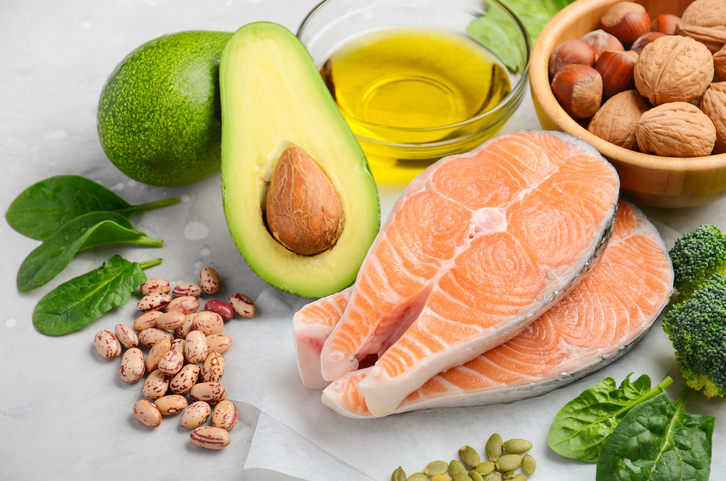- solen.sk - The importance of omega-3s in relation to ADHD
- alphamedical.sk - Fish oil
- solen.sk - about omega-3 fatty acids in the treatment of dyslipidemia
Our bodies need omega-3 fatty acids. Are we getting enough of them?

Today's diets often lead to an increased intake of fatty foods. The harmfulness of excessive fat intake is well known. However, omega-3 fatty acids are among the beneficial components of fats that are not only harmless but even essential for our health.
Article content
- The effect of omega-3 fatty acids on the heart and blood vessels
- Fat, cholesterol and dyslipidaemia
- Omega-3 fatty acids and cell membranes
- Omega-3 fatty acids in the treatment of ADHD
- Use of omega-3 fatty acids in pregnancy
- Immunity and omega-3s
- Summary of the positive benefits of omega-3 fatty acids:
- Intake of omega-3 and omega-6 fatty acids
- Where to find omega-3 fatty acids
They are a component of many biologically important substances. They are involved in various functions in the cell membrane and also have a supply function. They therefore represent a source of energy. Some are also involved in intracellular signals and thus influence, for example, muscle contraction or pain signals.
The distribution of fatty acids
| by chain length | short chain | (SCFA) |
| medium chain | (MCFA) | |
| long chain | (LCFA) | |
| very long chain | (VLCFA) | |
| by saturation | saturated fatty acids | (SFA) |
| monounsaturated fatty acids | (MUFA) | |
| polyunsaturated fatty acids | (PUFA) | |
| by intake | the body can make them | non-essential |
| the body cannot make them | essential |
Omega-3 fatty acids belong to the group of so-called polyunsaturated fatty acids (PUFA). They are essential, so the body cannot make them. They must therefore be taken in through food.
The effect of omega-3 fatty acids on the heart and blood vessels
Their positive effect on the cardiovascular system includes several beneficial effects in many ways. One is that it minimizes the risk of heart rhythm disorders.
They improve the ability of red blood cells to change their shape. As a result, they also penetrate capillaries, which are smaller than the red blood cells themselves. This improves microcirculation, in which oxygen and important substances are exchanged between the tissues and the blood.
They reduce the clumping of blood clots that flow through the blood vessels. They promote what is known as thrombolysis, which is the dissolution of blood clots. They reduce the extent of damage during ischaemia - a condition where a blood vessel is narrowed or completely blocked. They also promote the regeneration of the inner lining of blood vessels and the heart, for example during a myocardial infarction.

All these abilities of omega-3 fatty acids lead to a possible improvement in prognosis and treatment in patients not only after a heart attack, but also with heart failure or rhythm disorders.
The key is their unique hypolipidemic, anti-inflammatory and antithrombotic properties, i.e. their ability to lower total cholesterol levels and prevent blood clots.
You may also be interested in the magazine article.
Fat, cholesterol and dyslipidaemia
Fats (otherwise known as lipids) are compounds of glycerol and higher fatty acids. They are essential for life and a person must take in a certain amount to maintain his health. Their function is, for example, to bring vitamins A, D, E and K into the body.
Cholesterol is a fatty substance that is essential to the life of the body. They form part of some hormones and are also part of bile acids, which are important in the absorption of fats from the intestines. We get it from food, but 2/3 is formed by the body itself in the liver and digestive tract.
Cholesterol is a component of every cell in the human body.
Total cholesterol is divided into HDL (so-called good cholesterol) and LDL (bad cholesterol). Excess bad cholesterol is deposited in the walls of blood vessels, contributing to atherosclerosis. Good cholesterol, on the other hand, removes excess bad cholesterol from blood vessels. It also has anti-inflammatory and antioxidant properties.
The first information on the protective effect of omega-3 fatty acids on the heart in Inuit dates back to 1976.
Excessive dietary intake of saturated fat, lack of exercise or smoking are major contributors to elevated LDL cholesterol.
Cholesterol values
| Norm | up to 5,2 mmol/l |
| elevated levels | 5.2-6.2 mmol/l |
| high level | above 6.2 mmol/l |
| very high risk level | above 7.8 mmol/l |
Dyslipidemia is the name for an increase in total cholesterol. Specifically, it is an increase in bad cholesterol, triglycerides, and a slight decrease in good cholesterol.
Omega-3 fatty acids increase good (HDL) cholesterol. They are also important in preventing the development of acute pancreatitis, which is inflammation of the pancreas caused by various stimuli. It is most often associated with indigestion or excessive alcohol use.
Omega-3 fatty acids and cell membranes
The cell is the basic building block of the organism. Tissues are made up of cells, organs are made up of tissues. Simply put, our body is made up of individual cells.
Their membranes have an irreplaceable function, in the sense of transporting various important substances between them. A lack of function of cell membranes results in a number of health problems, such as irregular heartbeat, certain types of cancer, asthma or attention deficit disorders and depression.
Omega-3 fatty acids in the treatment of ADHD
ADHD - Attention Deficit Hyperactivity Disorder - is a disorder characterized by feelings of inner restlessness, impulsivity and an inability to concentrate. It manifests itself in childhood, especially at school age.
Without early detection, individuals suffering from this disorder are scarred for life. They are unable to apply themselves socially and even professionally. Treatment involves psychopharmaceuticals, psychiatric help and other regimes at home and at school.
Certain studies have shown the benefits of omega-3 fatty acids in ADHD and dyslexia (reading disorder). Positive effects of omega-3 fatty acids have also been observed in inattention, hyperactivity and impulsivity, which are the core symptoms of ADHD. In the sample studied, significant improvement in visual-motor coordination, visual perception and reduction in fatigue and restlessness have been shown.
Thus, it is demonstrable that this fatty acid is one of the effective and safe options to address the learning and behavioural problems of children.
Use of omega-3 fatty acids in pregnancy
The fetus draws omega-3 fatty acids from the placenta during pregnancy.
Several studies and statistics show that children whose mothers have enough omega-3 fatty acids in their diets learn to speak more easily, have a larger vocabulary, better visual acuity, spatial orientation or ability to grasp objects.

Immunity and omega-3s
Long-term use of fish oil or omega-3 concentrate has been shown to improve the immune system. It has been observed to shorten the course of inflammatory processes, reduce the risk of post-surgical complications or reduce chronic inflammation.
Summary of the positive benefits of omega-3 fatty acids:
These polyunsaturated fatty acids are therefore beneficial in multiple ways. Perhaps most important is the effect on the heart and blood vessels, but there is increasing talk of other benefits of their intake.
To reiterate:
- they raise HDL (good cholesterol) levels
- prevent the clumping of platelets, thereby preventing blood clots
- reduce blood density
- lowers blood pressure
- prevent heart rhythm disorders
- prevention of certain cancers
- alleviate symptoms of depression and other mental illnesses
- help alleviate ADHD and other attention deficit disorders
- improve immunity
- positive impact on the child during pregnancy
Intake of omega-3 and omega-6 fatty acids
Currently, our population consumes too much omega-6 and not enough omega-3 fatty acids. We need both for a beneficial effect on our bodies, but in specific amounts.
The optimal ratio of omega-6 to omega-3 is considered to be 1:1 to 4:1. However, poor dietary habits can lead to ratios as high as 30:1. Sources of omega-6 fatty acids include sunflower, corn and soybean oils.
A deficiency of omega-3 fatty acids can cause these non-specific problems, among others:
- Fatigue
- dry skin
- brittle nails and hair
- intestinal constipation
- depression
- joint pain

Where to find omega-3 fatty acids
These are found mainly in marine fish such as salmon, tuna and mackerel.
Perhaps the best-known representative is the not-so-popular fish oil. However, this dietary supplement has now changed its form and taste. It is available, for example, in capsule form.
A plant-based source of omega-3 fatty acids is alpha-linolenic acid, which is found in flaxseeds, walnuts, rapeseed, hazelnuts and almonds.
In smaller concentrations, fatty acids are also naturally found in all vegetables. A varied diet rich not only in fruit but also in vegetables and various fruits ensures a certain supply of omega fatty acids.
Zdroje omega -3 mastných kyselín
Interesting resources










